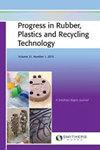对再生聚对苯二甲酸乙二醇酯塑料进行酸性水解制备其单体对苯二甲酸
IF 1.6
4区 材料科学
Q4 MATERIALS SCIENCE, COMPOSITES
Progress in Rubber Plastics and Recycling Technology
Pub Date : 2022-09-15
DOI:10.1177/14777606221128038
引用次数: 2
摘要
消费后的聚对苯二甲酸乙二醇酯(PET)塑料瓶,经过一定的预处理,化学解聚,得到PET树脂的重要单体——对苯二甲酸(TPA)。PET水解的最佳条件为100℃,80% v/v硫酸水溶液,反应时间30 min。用烧结玻璃过滤器从反应混合物中过滤出对苯二甲酸(TPAs)。在将回收的水解液用于连续批次的PET解聚之前,对其粘度进行了测定。水解液粘度从5 mm2/s逐渐增大到87 mm2/s。TPA得率为85.03±0.03% ~ 99.20±0.06%,成品TPA颜色由亮白色变为灰白色。TPA的结构通过FTIR、质谱和1H-NMR进行了确证。通过外标技术,高效液相色谱法测定TPA的纯度为95-98%。热重分析(TGA)确定了TPAs的热降解模式和残余重量。实验表明,从资源利用率、TPA质量和可持续性方面考虑,重复使用硫酸水解液是PET解聚的一个很好的选择。图形抽象本文章由计算机程序翻译,如有差异,请以英文原文为准。
Acidic hydrolysis of recycled polyethylene terephthalate plastic for the production of its monomer terephthalic acid
Post-consumer polyethylene terephthalate (PET) plastic bottles, after some pre-processing, were chemically depolymerized for the production of terephthalic acid (TPA), an important monomer of PET resin. The optimized condition of PET hydrolysis was 100°C with 80% v/v aqueous sulfuric acid liquor for 30 min reaction time. The terephthalic acids (TPAs) were filtered out from the reaction mixtures with a sintered glass filter. The viscosity of recycled hydrolysis liquor was measured before it was used in a successive batch of PET depolymerization. The viscosity of hydrolysis liquor increased gradually from 5 mm2/s to 87 mm2/s. TPA yields were obtained from 85.03 ± 0.03% to 99.20 ± 0.06% and the color of TPA changed from bright white to off-white in the final batches. The structure of TPA was confirmed by FTIR, mass analysis, and 1H-NMR spectroscopy. The purity of TPA was found to be 95–98% from the HPLC study via external calibration technique. Thermogravimetric analysis (TGA) determined the thermal degradation patterns of TPAs and residual weights. This experiment reveals that repeated use of sulfuric acid hydrolysis liquor would be a good option for PET depolymerization in terms of resource utilization, TPA quality as well as sustainability. Graphical Abstract
求助全文
通过发布文献求助,成功后即可免费获取论文全文。
去求助
来源期刊

Progress in Rubber Plastics and Recycling Technology
MATERIALS SCIENCE, COMPOSITES-POLYMER SCIENCE
CiteScore
4.40
自引率
7.70%
发文量
18
审稿时长
>12 weeks
期刊介绍:
The journal aims to bridge the gap between research and development and the practical and commercial applications of polymers in a wide range of uses. Current developments and likely future trends are reviewed across key areas of the polymer industry, together with existing and potential opportunities for the innovative use of plastic and rubber products.
 求助内容:
求助内容: 应助结果提醒方式:
应助结果提醒方式:


